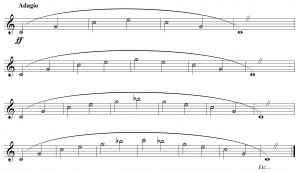The article that follows was something that was published in an International Trumpet Guild Journal a number of years ago.
Part II Strength-Flexibility
The body consists of muscles that work in primarily two contexts. Slow-twitch muscles are used for activities that require a great deal of strength, and the Fast-twitch muscles are used for quick, repetitive or graceful maneuvers. Two sets of visual examples would be comparing an Olympic sprinter to a marathon runner or comparing a pro football linebacker to a pro tennis player. Each of these examples represents athletes in highly specialized fields and their bodies reflect in a general way how they use their muscles. To build mass in a muscle the weight lifter lifts their maximum weight slowly a few times (100lbs 5xs) and to build definition and agility the bodybuilder lifts lighter weights many repetitions, (5lbs 100xs).
The tricky part for trumpet players is we have to use the muscles in our embouchure to achieve results that utilize both sets of muscle groups. We have to be able to play loudly, have a good range and endurance and also play with subtlety and agility. These are kind of contradictory actions on the part of our muscles. For example, how many of you have spent the first part of your school year playing in marching band? Then around November, you go inside and sit down in wind ensemble/concert band or orchestra for the first time and are asked to play a phrase piano. You probably feel a little like a bull in a china shop, right? This is because you have become muscle-bound through the high and loud playing associated with marching band. Your range and endurance are in great shape but your nuance is a little dusty. If this describes you, your warm-up routine diet is a little unbalanced.
To help balance my diet I think of lip slurs in basically two configurations; slow, moderately loud, going from low to high to low. This works on range, endurance and power. (Football player slurs) Adding intervals to the slow arched-shaped lip slurs is like putting another weight on the barbell.
Alternately, when slurs are played lightly and in closer intervals at a moderately quiet volume they develop refinement and agility. (Tennis player slurs) Working for speed and accuracy on close-interval slurs will give the player agility, flexibility and help refine the players’ response for very soft, delicate passages.
Range, endurance, intervallic flexibility, and sensitivity of response are all related to how the player has conditioned their embouchure. When you find yourself in marching band season, I suggest you focus on your “Tennis player slurs” and conversely if you are on a section part in wind ensemble or orchestra keep your “Football player slurs” in shape to keep your muscles balanced, strong and supple.
Other related posts
5 Comments
Comments are closed.



[…] Part 2 […]
[…] Part 2 […]
[…] Part 2 […]
[…] his clip but just want to completely support his approach to flexibility. I wrote on this subject here and I think you will find a lot of similarities our […]
Hi, Dave,
I followed a link from Jim Stephenson’s site and discovered yours. So much good stuff here!
I particularly was interested in your warm-up routine: I’ll be giving a presentation at the Midwest Tp. Fest. in 10 days and would definitely refer the students to your article.
Somehow pp. 3 and 4 are not available.
I was hoping to see you in Pittsburg, but looks like you are not coming this year.
Take care and thank you again for the great website!
Iskander